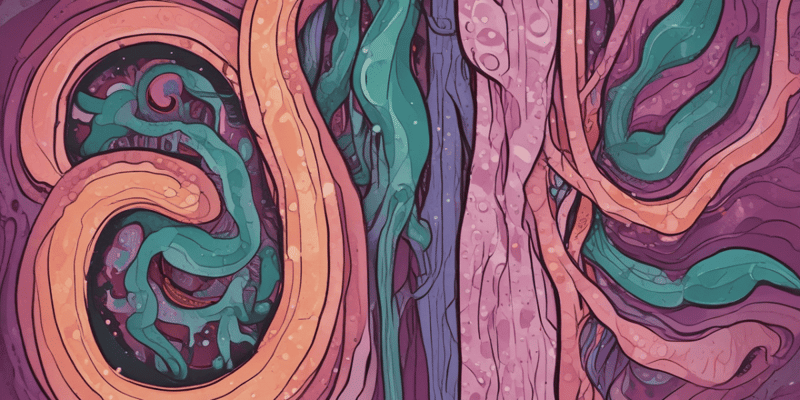Questions and Answers
Which blood test result is more likely to be positive in Crohn's disease?
Elevated ESR
What is a common characteristic of Ulcerative Colitis based on stool analysis?
Elevated WBCs
What is a distinguishing radiological sign that may be seen in Crohn's disease?
String sign
Which is a complication more commonly associated with Ulcerative Colitis?
Signup and view all the answers
What is a common feature of Crohn's disease endoscopic appearance?
Signup and view all the answers
Which laboratory test result is more indicative of Ulcerative Colitis?
Signup and view all the answers
What is a potential complication specific to Crohn's disease?
Signup and view all the answers
What is a characteristic feature of Ulcerative Colitis endoscopic findings?
Signup and view all the answers
Which complication would NOT be typically seen in Ulcerative Colitis?
Signup and view all the answers
What treatment option is commonly used for both Ulcerative Colitis and Crohn's disease?
Signup and view all the answers
Study Notes
Inflammatory Bowel Disease (IBD)
- IBD includes Ulcerative Colitis (UC) and Crohn's Disease (CD)
- UC: inflammation of the mucosa and submucosa of the colon and rectum
- CD: transmural inflammation that can affect any part of the GI tract
Diagnostics
- Fecal leukocytes: to rule out infectious diarrhea
- Colonoscopy: to assess the extent of disease and the presence of any complications
Complications
- Iron deficiency anemia
- Hemorrhage
Crohn Disease vs Ulcerative Colitis
- Crohn Disease:
- Transmural involvement (intestinal wall from mucosa to serosa)
- Discontinuous involvement (skip lesions)
- Can involve any part of the GI tract
- Colectomy is not curative (recurrences occur)
- Complications: fistulae and abscesses are more common than in UC
- Extraintestinal manifestation: more common than in UC
- Ulcerative Colitis:
- Mucosa and submucosa involvement
- Confined to colon and rectum
- Colectomy is curative
- Continuous involvement (no skip lesions)
Crohn's Disease
- Anatomic distribution:
- Ileocolic (45%)
- Small bowel alone (33%)
- Colon alone (20%)
- Rectal sparing
- Clinical presentation:
- RLQ pain (postprandial) and palpable mass
- Diarrhea (watery)
- Rectal bleeding
- Malabsorption and weight loss
- Fever
- Growth retardation in children
- Perirectal fistula
- Extraintestinal manifestations:
- Skin: erythema nodosum, pyoderma gangrenosum
- Joints: peripheral arthritis, sacroiliitis, AS
- Eye: uveitis, episcleritis, iritis
- Hepatobiliary complications: gallstones, PSC
- Renal complications: nephrolithiasis, recurrent UTIs
Crohn's Disease Activity Index
- Liquid or very soft stools/day
- Abdominal pain and cramping
- Extraintestinal manifestations
- Complications
- Abdominal mass
- Use of anti-diarrheal medications
- Hematocrit
- Body weight
Extraintestinal Manifestations of IBD
- Eye lesions:
- Episcleritis: parallels bowel disease activity
- Anterior uveitis: independent course
- Skin lesions:
- Erythema nodosum: especially in Crohn disease; parallels bowel disease activity
- Pyoderma gangrenosum: especially in UC; parallels bowel disease activity in 50% of cases
- Arthritis:
- Migratory monoarticular arthritis: parallels bowel disease activity
- Ankylosing spondylitis: patients with UC have a 30 times greater incidence of ankylosing spondylitis than the general population; the course is independent of the colitis
- Sacroiliitis: does not parallel bowel disease activity
- Thromboembolic-hypercoagulable state: can lead to deep venous thrombosis (DVT), pulmonary embolism (PE), or a cardiovascular accident (CVA)
- Idiopathic thrombocytopenic purpura
- Osteoporosis
- Gallstones in Crohn disease (ileal involvement)
- Sclerosing cholangitis in UC
Studying That Suits You
Use AI to generate personalized quizzes and flashcards to suit your learning preferences.
Description
Test your knowledge on the key differences between Crohn disease and ulcerative colitis, including their involvement, location, and complications. Questions cover topics such as transmural involvement, mucosa and submucosa, and distinguishing features of each condition.




